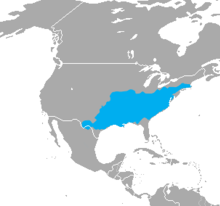
Back Qonurbaş qalxansifət Azerbaijani Медноглава змия Bulgarian Agkistrodon contortrix Catalan Agkistrodon contortrix CEB A'kêstséahe CHY Nordamerikanischer Kupferkopf German Agkistrodon contortrix Spanish Agkistrodon contortrix Basque Agkistrodon contortrix French Nathair choparcheannach Irish
| Eastern copperhead | |
|---|---|

| |
| Scientific classification | |
| Domain: | Eukaryota |
| Kingdom: | Animalia |
| Phylum: | Chordata |
| Class: | Reptilia |
| Order: | Squamata |
| Suborder: | Serpentes |
| Family: | Viperidae |
| Genus: | Agkistrodon |
| Species: | A. contortrix
|
| Binomial name | |
| Agkistrodon contortrix (Linnaeus, 1766)
| |

| |
| Synonyms[2] | |
| |
The eastern copperhead (Agkistrodon contortrix),[3] also known simply as the copperhead, is a species of venomous snake, a pit viper, endemic to eastern North America; it is a member of the subfamily Crotalinae in the family Viperidae.
The eastern copperhead has distinctive, dark brown, hourglass-shaped markings, overlaid on a light reddish brown or brown/gray background. The body type is heavy, rather than slender. Neonates are born with green or yellow tail tips, which progress to a darker brown or black within one year. Adults grow to a typical length (including tail) of 50–95 cm (20–37 in).
In most of North America, the eastern copperhead favors deciduous forest and mixed woodlands. It may occupy rock outcroppings and ledges, but is also found in low-lying, swampy regions. During the winter, it hibernates in dens or limestone crevices, often together with timber rattlesnakes and black rat snakes.[4] The eastern copperhead is known to feed on a wide variety of prey, including invertebrates (primarily arthropods) and vertebrates. Like most pit vipers, the eastern copperhead is generally an ambush predator; it takes up a promising position and waits for suitable prey to arrive.
As a common species within its range, it may be encountered by humans. Unlike other viperids, it often "freezes" instead of slithering away and fleeing, due to its habit of relying on excellent camouflage.[5] Bites occur due to people unknowingly stepping on or near them.[6] Copperhead bites account for half of the treated snake bites in the United States.[7]
Five subspecies have been recognized in the past,[8] but recent genetic analysis had yielded new species information.
- ^ Frost, D.R.; Hammerson, G.A.; Santos-Barrera, G. (2007). "Agkistrodon contortrix ". IUCN Red List of Threatened Species. 2007: e.T64297A12756101. doi:10.2305/IUCN.UK.2007.RLTS.T64297A12756101.en. Retrieved 12 November 2021.
- ^ Cite error: The named reference
McD99was invoked but never defined (see the help page). - ^ Moriarty, John J. (2017). Scientific and standard English names of amphibians and reptiles of North America north of Mexico with comments regarding confidence in our understanding. 8th ed. Society Study Amphibians and Reptles Herpetological Circular 43.
- ^ "Northern copperhead". Smithsonian's National Zoo. 2016-04-25. Retrieved 2017-06-29.
- ^ Allf, Bradley C.; Durst, Paul A. P.; Pfennig, David W. (October 2016). "Behavioral Plasticity and the Origins of Novelty: The Evolution of the Rattlesnake Rattle". The American Naturalist. 188 (4): 475–483. doi:10.1086/688017. PMID 27622880.
- ^ "Venomous Snakes". National Institute for Occupational Safety and Health. Retrieved on November 10, 2008.
- ^ Mullins, Michael E.; Freeman, William E. (September 2020). "Thromboelastometry (ROTEM) and thromboelastography (TEG) in copperhead snakebites: a case series". Clinical Toxicology. 58 (9): 931–934. doi:10.1080/15563650.2020.1713332. PMID 31997668.
- ^ "Agkistrodon contortrix ". Integrated Taxonomic Information System. Retrieved 28 November 2006.
© MMXXIII Rich X Search. We shall prevail. All rights reserved. Rich X Search
